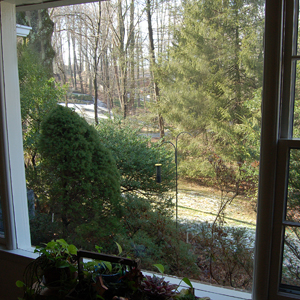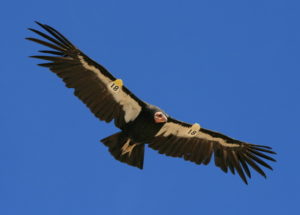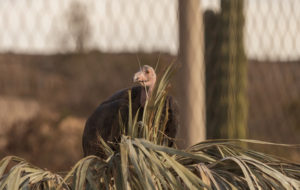View From
Rachel’s Window

Caring Individuals As Guardians of California Condors, America’s Largest Birds
Work at Protecting Them from Human-Generated Hazards
From Rachel’s study window, through the trees, it is possible to see an occasional vehicle driving along the road by the wild area of the property. Sadly the ditches and grassy areas that border the wild area are where bits of microtrash (bottle caps, broken glass, tabs from drink containers, etc.) collect. The ditch between the road and the property is also the place where tadpoles can be seen and where wild footprints are visible in the muddy low places. Birds and frogs live in the wild area. Our periodic clean up patrols help keep their habitat litter free.
 While many problems are related to microtrash reaching streams and rivers, a recent hazard from anthropogenic (human originating) litter occurred to a very special bird. The California condori mentioned by Dr. Porter at the 2016 Open House, was and is being threatened by lead poisoning, among other factors. The global population was down to 27 captive adult Condors in 1987, when a captive breeding program was initiated to rescue the species. Young birds from this program started to be released in 1992. Survival rates were low due to failure of baby birds to thrive in the nest. A program was started with knowledgeable individuals assigned as guardians to monitor the health of condors in the nests. Contributing to condor nest failure were West Nile Virus infections and anthropogenic microtrash ingestion by chicks. “As curious, scavenging birds, condors are attracted to… broken glass, bottle caps, and can tabs, which may be mistaken for nutrient-rich bone fragments and can be deadly [especially to chicks] if ingested.” (Sandhaus, E., “Flying Free Once More: Nest Guarding in the Reintroduced California Condor,” AWI Quarterly, Summer 2016)
While many problems are related to microtrash reaching streams and rivers, a recent hazard from anthropogenic (human originating) litter occurred to a very special bird. The California condori mentioned by Dr. Porter at the 2016 Open House, was and is being threatened by lead poisoning, among other factors. The global population was down to 27 captive adult Condors in 1987, when a captive breeding program was initiated to rescue the species. Young birds from this program started to be released in 1992. Survival rates were low due to failure of baby birds to thrive in the nest. A program was started with knowledgeable individuals assigned as guardians to monitor the health of condors in the nests. Contributing to condor nest failure were West Nile Virus infections and anthropogenic microtrash ingestion by chicks. “As curious, scavenging birds, condors are attracted to… broken glass, bottle caps, and can tabs, which may be mistaken for nutrient-rich bone fragments and can be deadly [especially to chicks] if ingested.” (Sandhaus, E., “Flying Free Once More: Nest Guarding in the Reintroduced California Condor,” AWI Quarterly, Summer 2016)
 The condor nest guarding program (involving the US Fish and Wildlife Service and other partners) helped raise the survival rate of released condors by vaccinating birds for West Nile virus, when necessary providing surgery to remove trash from chicks’ intestinal tracts, and organizing trash cleanups near the nests. More recently an additional contributing factor to survival of condors in nature is the birds spending more time foraging in wild areas away from humans and their trash. “While condors remain critically endangered and are still threatened by anthropogenic factors (e.g., lead, trash ingestion, and habitat loss) the species appears to be on the road to recovery.”ii (Sandhaus, E., “Flying Free Once More: Nest Guarding in the Reintroduced California Condor,” AWI Quarterly, Summer 2016)
The condor nest guarding program (involving the US Fish and Wildlife Service and other partners) helped raise the survival rate of released condors by vaccinating birds for West Nile virus, when necessary providing surgery to remove trash from chicks’ intestinal tracts, and organizing trash cleanups near the nests. More recently an additional contributing factor to survival of condors in nature is the birds spending more time foraging in wild areas away from humans and their trash. “While condors remain critically endangered and are still threatened by anthropogenic factors (e.g., lead, trash ingestion, and habitat loss) the species appears to be on the road to recovery.”ii (Sandhaus, E., “Flying Free Once More: Nest Guarding in the Reintroduced California Condor,” AWI Quarterly, Summer 2016)
Caring about birds (and other wildlife) means being aware that they may pick up microtrash (small pieces of plastic, foil, pesticide granules or other bits of anthropogenic debris) believing it to be food. Avoiding use of granular pesticides and fertilizers and removing trash from the environment where birds may mistakenly feed it to their young can help counteract this negative anthropogenic effect on wildlife. If each of us resolved to pick up at least one piece of trash per day-it could make a difference.
1 On the US Fish and Wildlife Service Endangered Species List – as of July 4, 2016
ii (Wild population reported to be 270 (Klein, Karin, Yale Environment 360- as reported in online e360 digest, “California Condor Population Reaches New Heights in 2015.” June 2016.)
For past View from Rachel’s Window articles click here

